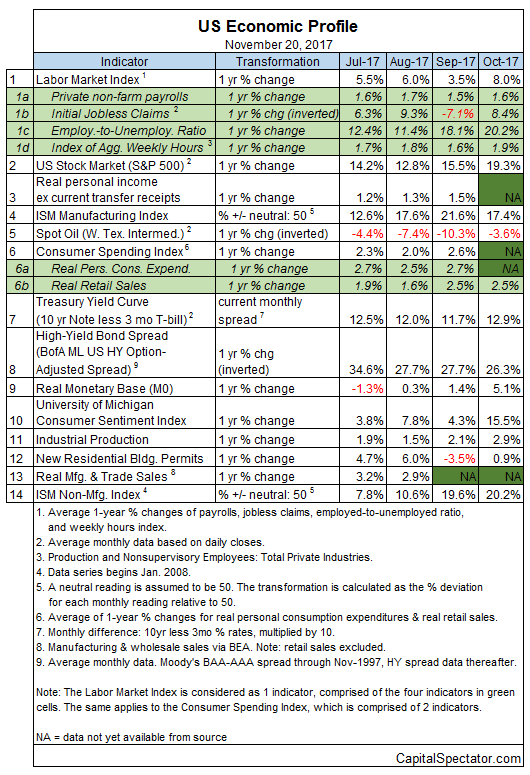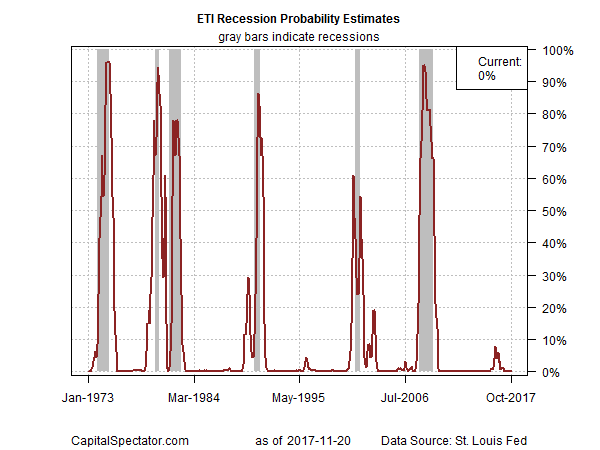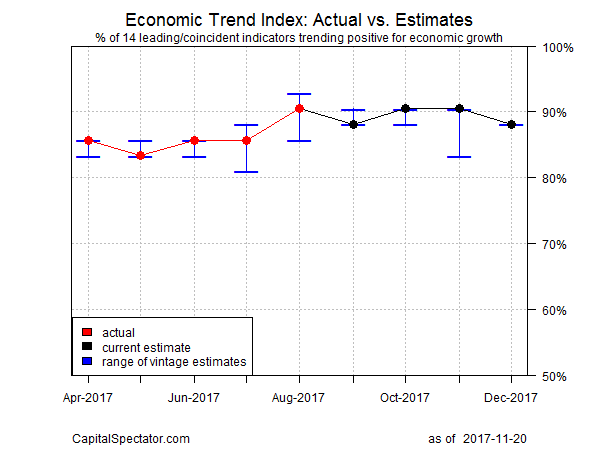As economic activity continues to trend solidly positive in the latest roundup of numbers. In turn, recession risk remains virtually nil, based on the available data through October. The near-term outlook looks upbeat, too, suggesting that the recent strength in GDP growth will continue in the fourth quarter.
Using preliminary numbers published to date paints a rosy profile for a broad set of indicators. Indeed, the only headwind at the moment is in the oil market: crude prices have been trending higher in recent months in year-over-year terms. Otherwise, the data points to a solid pace of economic output in recent history.
Not surprisingly, the outlook for Q4 GDP growth looks bullish, according to several forecasts. The Atlanta Fed’s GDPNow model is projecting (as of November 17) that output will pick up to 3.4% in the final three months of the year, moderately above the 3.0% rise in Q3. The New York Fed’s Q4 estimate (Nov. 17) is even higher at 3.8%. Wall Street economists, however, are anticipating that growth will cool slightly in Q4 to a 2.8% pace, based on CNBC’s survey at last week’s close.
Meantime, the latest estimate of recession risk for the US remains low, based on The Capital Spectator’s business-cycle benchmarks, which reflect a diversified set of economic datasets. Most of the underlying indicators for October have been published and the majority continue to reflect a positive trend. (For a more comprehensive review of the macro trend on a weekly basis, see The US Business Cycle Risk Report.)

Aggregating the data in the table above continues to translate into a positive bias overall. The Economic Trend and Momentum indices (ETI and EMI, respectively) remain well above their respective danger zones (50% for ETI and 0% for EMI). When/if the indexes slide below those tipping points, the declines will mark clear warning signs that recession risk is elevated and a new downturn is likely. The analysis is based on a methodology that’s profiled in my book on analyzing the business cycle.

Translating ETI’s historical values into recession-risk probabilities via a probit model also points to low business-cycle risk for the US through last month. Analyzing the data in this framework indicates that the odds remain close to zero that NBER will declare October as the start of a new recession.

For some insight on the near-term outlook, consider how ETI may evolve as new data is published. One way to project values for this index is with an econometric technique known as an autoregressive integrated moving average (ARIMA) model, based on calculations via the “forecast” package in R. The ARIMA model calculates the missing data points for each indicator for each month — in this case through December 2017. (Note that August 2017 is currently the latest month with a full set of published data). Based on today’s projections, ETI is expected to remain well above its danger zone through next month.

Forecasts are always suspect, but recent projections of ETI for the near-term future have proven to be reliable guesstimates vs. the full set of published numbers that followed. That’s not surprising, given ETI’s design to capture the broad trend based on multiple indicators. Predicting individual components, by contrast, is subject to greater uncertainty. The assumption here is that while any one forecast for a given indicator will likely be wrong, the errors may cancel out to some degree by aggregating a broad set of predictions. That’s a reasonable view, according to the generally accurate historical record for the ETI forecasts in recent years.
The current projections (the four black dots in the chart above) suggest that the economy will continue to expand. The chart above also includes the range of vintage ETI projections published on these pages in previous months (blue bars), which you can compare with the actual data (red dots) that followed, based on current numbers.
For more perspective on the track record of the forecasts, here are the previous business-cycle risk updates for the last three months:
24 Oct 2017
20 Sep 2017
16 Aug 2017
Note: ETI is a diffusion index (i.e., an index that tracks the proportion of components with positive values) for the 14 leading/coincident indicators listed in the table above. ETI values reflect the 3-month average of the transformation rules defined in the table. EMI measures the same set of indicators/transformation rules based on the 3-month average of the median monthly percentage change for the 14 indicators. For purposes of filling in the missing data points in recent history and projecting ETI and EMI values, the missing data points are estimated with an ARIMA model.
Disclosure: Originally published at Saxo Bank TradingFloor.com
